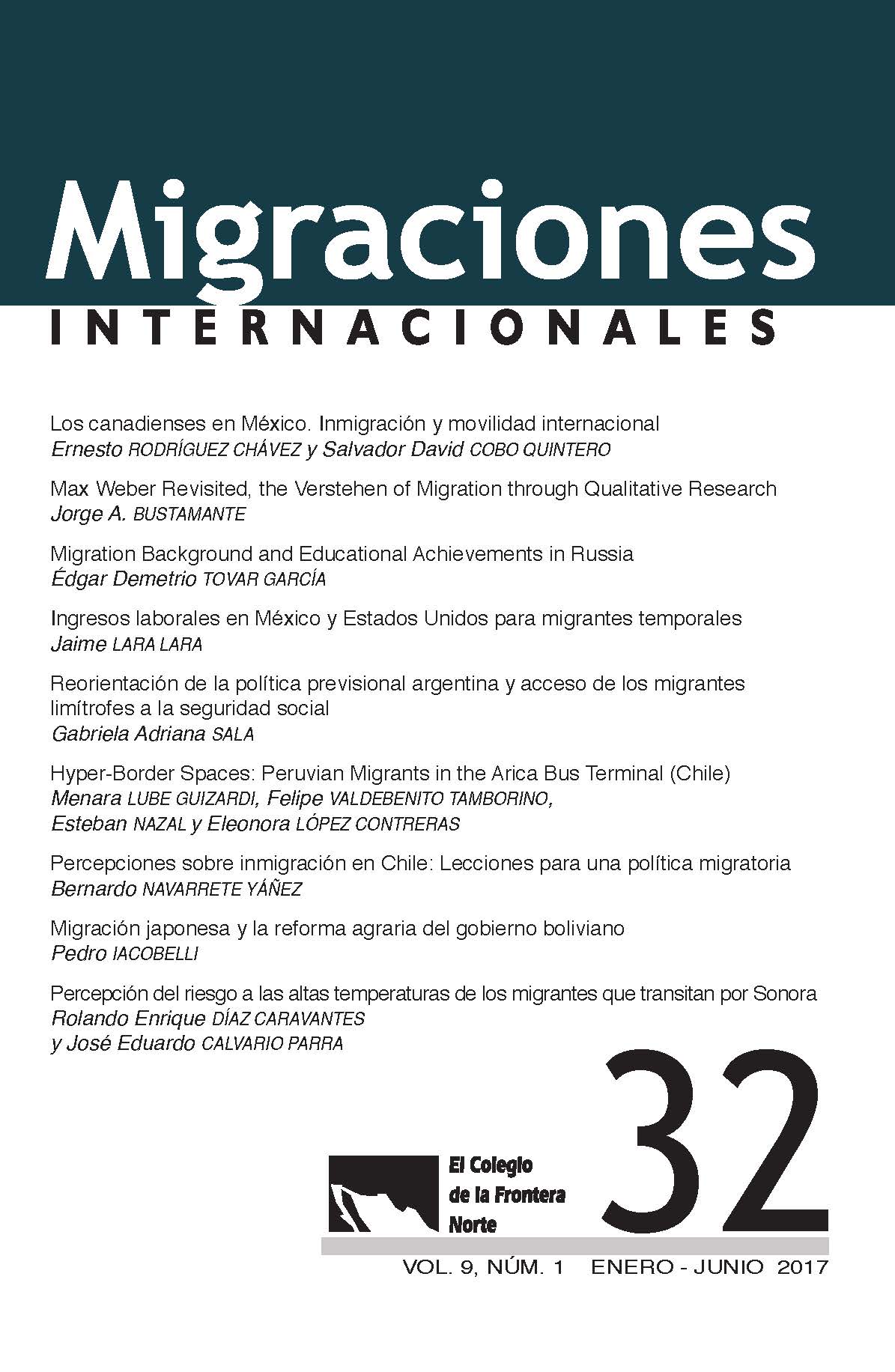Retomando a Max Weber. Comprender la migración a través de la investigación cualitativa
DOI:
https://doi.org/10.17428/rmi.v9i32.887Palabras clave:
relación social, migración internacional, vulnerabilidad, observación participante, investigación cualitativaResumen
Se incluye 1) una reinterpretación de un par de conceptos básicos (Gemeinten Sinn y Verstehen) de Max Weber. Se define a la migración internacional (inmigración) como una relación social de carácter laboral. Se hace referencia al libro de Ernesto Galarza. La noción teórica de Verstehen entendida por Weber como un “entendimiento profundo” de un fenómeno social, da lugar a la narración que hace el autor, derivada del uso del 2) método de “observación participante” de una experiencia personal. De ésta se deriva el concepto de vulnerabilidad que implica una innovación a los enfoques teóricos de la migración. Lo anterior se encuadra en un enfoque metodológico de investigación cualitativa de la cual 3) no se desprenden “hallazgos” en su sentido empírico, sino explicaciones complementarias del “sentido” de los hechos relatados. 4) El encuentro del autor con un compañero migrante en el centro de detención, se presenta como el origen empírico del concepto de vulnerabilidad.
Referencias
BRUYN, Severyn T., 1969, The Human Perspective in Sociology: The Methodology of Participant Observation, New Jersey, Prentice-Hall.
BUSTAMANTE, Jorge Agustín [doctoral thesis], 1975, Mexican Immigration and the Social Relations of Capitalism, Indiana, U. S., University of Notre Dame.
BUSTAMANTE, Jorge Agustín, 1978, “Commodity Migrants: Structural Analysis of Mexican Immigration,” in Stanley Ross, ed., Views Across the Border: The United States and Mexico, Albuquerque, New Mexico, U. S., University of New Mexico Press, pp. 183-225.
BUSTAMANTE, Jorge A., 2002, Migración internacional y derechos humanos, Mexico City, UNAM, Instituto de Investigaciones Jurídicas.
BUSTAMENTE, Jorge A., 2007, “A Dialectical Understanding of the Vulnerability of International Migrants,” in Hernan Vera and Joe R. Feagin, eds., Handbook of the Sociology of Racial and Ethnic Relations, New York, Springer, pp. 161-190
BUSTAMANTE, Jorge A., 2016, “Mexican Immigration to the United States, the vulnerability of migrants and their circularity,” in Solé, Carlota; Ssonia Parella, Teresa Sordé, and Sonia Nita, eds., Impact of Circular Migration on Human, Political and Civil Rights. A Global Perspective, New York, U. S., Springer, pp. 63-84.
GALARZA, Ernesto, 1964, Merchants of Labor: The Mexican Bracero Story, Charlotte, Santa Barbara, McNally & Lofetin.
GARFINKEL, Harold, 2002, Ethnomethodology’s Program, New York, Rowman & Littlefield Publishers.
GARFINKEL, Harold, 2012, Studies in Ethnometodology, Malden, United States, Blackwell Publishing.
GREBLER, Leo; Joan W. Moore, and Ralph C. Guzmán, 1970, The Mexican American People, Free Pr.
LEWIS, Oscar, 1964, Pedro Martínez: A Mexican Peasant and His Family, Nueva York, Vintage Books; Trade Paperback Editions.
MCCALL, G. J., 1969, Issues in Participant Observation: A Text and a Reader, Massachusetts, United States, Addison-Wesley Pub.
MCWILLIAMS, Carrey, 1990, North from Mexico, Santa Bárbara, California, Praeger.
OJEDA GÓMEZ, Mario, 1976, Alcances y Limites de la política exterior de México, Mexico City, Colegio de México.
OJEDA GÓMEZ, Mario, 1982, “The Structural Context of US-Mexico Relations,” in Tomie Sue Montgomeri, comp., Mexico Today, Philadelphia, Institute for the Study of Human Issues.
OVERMYER-VELAZQUEZ, Mark, 2011, Beyond the Frontera: The History of U.S. Migration, New York, Oxford University Press.
PARSONS, Talcott, 1964, The Social System, New York, The Free Press of Glencoe.
PARSONS, Talcott, 1966, The Structure of Social Action, Illinois, Free Press.
REICH, Wendelin, 2010, “Three Problems of Intersubjectivity- and One Solution”, Sociological Theory, Vol. 28, No. 1, pp. 40-63.
SCHUTZ, Alfred, 1982, Collected Papers, The Problem of Social Reality, Hingham, United States, Springer.
SOROKIN, Pitrim, 1957, Social and Cultural Dynamic, (one volume edition), Boston, Extending Horizon Books.
TÖNNIES, Ferdinand, 2002, Community and Society, Mineola, New York, Dover Publications.
WEBER, Marianne, 1921, ed., Grundriss der Sozialökonomik, Alemania, Tübingen Edition.
Descargas
Publicado
Número
Sección
Licencia
Las/los autoras/es que publiquen en esta revista aceptan las siguientes condiciones:
- Las/los autoras/es conservan los derechos de autor y ceden a la revista Migraciones Internacionales (RMI) el derecho de la primera publicación, mediante el registro de los textos con la licencia de Creative Commons Atribución-No comercial-Sin derivar 4.0 internacional (CC BY-NC-ND 4.0), que permite a terceros utilizar lo publicado siempre que mencionen la autoría del trabajo y a la primera publicación en esta revista.
- Autorizan que su artículo y todos los materiales incluidos en él sean reproducidos, publicados, traducidos, comunicados y transmitidos públicamente en cualquier forma o medio; así como efectuar su distribución al público en el número de ejemplares que se requieran y su comunicación pública, en cada una de sus modalidades, incluida su puesta a disposición del público a través de medios electrónicos o de cualquier otra tecnología, para fines exclusivamente científicos, culturales, de difusión y sin fines comerciales.
- Los autores/as pueden realizar otros acuerdos contractuales independientes y adicionales para la distribución no exclusiva de la versión del artículo publicado en esta revista (por ejemplo: incluirlo en un repositorio institucional, página web personal; o bien publicarlo en un libro) siempre que sea sin fines comerciales e indiquen claramente que el trabajo se publicó por primera vez en Migraciones Internacionales (RMI), [agregando la ficha bibliográfica correspondiente: Autor/es. (año). Título del artículo. Migraciones Internacionales, volumen (número), pp. doi: xxxx ].
Para ello, las/los autoras/es deben remitir el formato de carta-cesión de la propiedad de los derechos de la primera publicación debidamente llenado y firmado. Este documento debe cargarse en formato PDF en archivos complementarios dentro de la plataforma OJS.
Este obra está bajo una licencia de Creative Commons Atribución-No comercial-Sin derivar 4.0 internacional (CC BY-NC-ND 4.0)..













